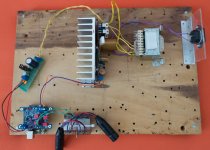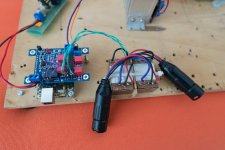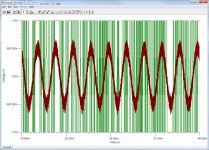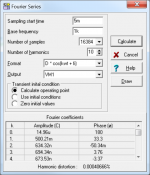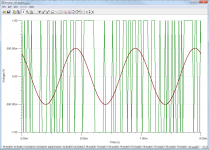I'm also interested, let us know.
Could you elaborate how to proceed to make the HQPlayer installed in a PC and the NAA service installed in the laptop?
Felipe
Could you elaborate how to proceed to make the HQPlayer installed in a PC and the NAA service installed in the laptop?
Felipe
I'm still sorting out my DSD player situation, but have been testing my flip-flop board a bit using a scope on the output. PCM input via USB to JLSounds is triggering the unmute relay, and I see a 5V signal at the PCM frequency on the right output. Just confirming: is this what others observe?
I would prefer that only DSD output could exit the board. Although, expanding the role of the 'no-DAC', I can imagine configurations in which the JLSounds' 'normal' PCM output might be useful. For example, some PCM is not currently amenable to DSD conversion. Examples would be output from PC-based video players, or from digital audio workstation and video editor software (which I sometimes use on my workstation that will run HQPlayer). It wouldn't take much 're-work' of the relay with pin 7/8 output to have a wonderful 'tandem' interface. DSD mutes the DAC (input or output), and PCM mutes DSD output. Is this reasonable, or am I missing something?
Cheers,
Frank
I would prefer that only DSD output could exit the board. Although, expanding the role of the 'no-DAC', I can imagine configurations in which the JLSounds' 'normal' PCM output might be useful. For example, some PCM is not currently amenable to DSD conversion. Examples would be output from PC-based video players, or from digital audio workstation and video editor software (which I sometimes use on my workstation that will run HQPlayer). It wouldn't take much 're-work' of the relay with pin 7/8 output to have a wonderful 'tandem' interface. DSD mutes the DAC (input or output), and PCM mutes DSD output. Is this reasonable, or am I missing something?
Cheers,
Frank
Last edited:
I have been able to get sound connecting the dsd out pins on the amanero straight into a i/p transformer, but have had no luck using the flip flop. Silence.
I must be doing something wrong. My best guess is that the flip flop is not syncing to the signal **** provided by the amanero. At the moment I am connecting the amanero ground to the flip flop one. Is there any reason why I should not do that? Otherwise digital cabling is short (3cm) and the amanero worked fine when I connect it to my Buffalo iii.
Many thanks in advance
Giulio
I must be doing something wrong. My best guess is that the flip flop is not syncing to the signal **** provided by the amanero. At the moment I am connecting the amanero ground to the flip flop one. Is there any reason why I should not do that? Otherwise digital cabling is short (3cm) and the amanero worked fine when I connect it to my Buffalo iii.
Many thanks in advance
Giulio
I have been able to get sound connecting the dsd out pins on the amanero straight into a i/p transformer, but have had no luck using the flip flop. Silence.
I must be doing something wrong. My best guess is that the flip flop is not syncing to the signal **** provided by the amanero. At the moment I am connecting the amanero ground to the flip flop one. Is there any reason why I should not do that? Otherwise digital cabling is short (3cm) and the amanero worked fine when I connect it to my Buffalo iii.
Many thanks in advance
Giulio
Can you post some pictures of your implementation?
Just a quick recap of my experience so far.
Flip flop board, both with and without isolating transformers (LL1676). 7805 for usb part of JLSounds board, Salas BiB for the isolated side and flip flops.
Muting relay takes perfect care of pops and generally there is low perceived noise and complete lack of switching artifacts.
A quick look with a scope at the output shows horrendous noise superimposed on a 1kHz sine. Changing the output filter values allows for a perfect, noise free 1kHz sine, but only at the expense of cutting into the audible range. A higher order filter looks like a must to me.
For listening tests i have only used 64 and 128 dsd files in dop and briefly tried the real time conversion of jriver from pcm.
Some tracks are listenable, but generally there is no comparison to a "real" dac. Especially poor are the bass and imaging. Voices are quite good.
Apart from the added voltage gain the transformers did not contribute anything worthwhile to the sound, so most of my listening was done without them.
My setup is not optimised for dsd and even less so for RT conversion. This may be a reason for the poor results. Still, a very entertaining project. Many thanks to Nautiboy for making it possible.
Flip flop board, both with and without isolating transformers (LL1676). 7805 for usb part of JLSounds board, Salas BiB for the isolated side and flip flops.
Muting relay takes perfect care of pops and generally there is low perceived noise and complete lack of switching artifacts.
A quick look with a scope at the output shows horrendous noise superimposed on a 1kHz sine. Changing the output filter values allows for a perfect, noise free 1kHz sine, but only at the expense of cutting into the audible range. A higher order filter looks like a must to me.
For listening tests i have only used 64 and 128 dsd files in dop and briefly tried the real time conversion of jriver from pcm.
Some tracks are listenable, but generally there is no comparison to a "real" dac. Especially poor are the bass and imaging. Voices are quite good.
Apart from the added voltage gain the transformers did not contribute anything worthwhile to the sound, so most of my listening was done without them.
My setup is not optimised for dsd and even less so for RT conversion. This may be a reason for the poor results. Still, a very entertaining project. Many thanks to Nautiboy for making it possible.
Attachments
Is the noise different in DSD64 vs DSD128? If DSD128 is less, DSD256 might help to shift the noise to higher filterable frequencies
Also, my intuition (FWIW) tells me that DSD 128 might not help at all while DSD256 freqs are high enough to make a difference.
Also, my intuition (FWIW) tells me that DSD 128 might not help at all while DSD256 freqs are high enough to make a difference.
Last edited:
Just a quick recap of my experience so far.
Flip flop board, both with and without isolating transformers (LL1676). 7805 for usb part of JLSounds board, Salas BiB for the isolated side and flip flops.
Muting relay takes perfect care of pops and generally there is low perceived noise and complete lack of switching artifacts.
A quick look with a scope at the output shows horrendous noise superimposed on a 1kHz sine. Changing the output filter values allows for a perfect, noise free 1kHz sine, but only at the expense of cutting into the audible range. A higher order filter looks like a must to me.
For listening tests i have only used 64 and 128 dsd files in dop and briefly tried the real time conversion of jriver from pcm.
Some tracks are listenable, but generally there is no comparison to a "real" dac. Especially poor are the bass and imaging. Voices are quite good.
Apart from the added voltage gain the transformers did not contribute anything worthwhile to the sound, so most of my listening was done without them.
My setup is not optimised for dsd and even less so for RT conversion. This may be a reason for the poor results. Still, a very entertaining project. Many thanks to Nautiboy for making it possible.
What filter values are you using?
Have you tried using better PSU to powering the JLSounds board?
Just a quick recap of my experience so far.
Flip flop board, both with and without isolating transformers (LL1676). 7805 for usb part of JLSounds board, Salas BiB for the isolated side and flip flops.
Muting relay takes perfect care of pops and generally there is low perceived noise and complete lack of switching artifacts.
A quick look with a scope at the output shows horrendous noise superimposed on a 1kHz sine. Changing the output filter values allows for a perfect, noise free 1kHz sine, but only at the expense of cutting into the audible range. A higher order filter looks like a must to me.
For listening tests i have only used 64 and 128 dsd files in dop and briefly tried the real time conversion of jriver from pcm.
Some tracks are listenable, but generally there is no comparison to a "real" dac. Especially poor are the bass and imaging. Voices are quite good.
Apart from the added voltage gain the transformers did not contribute anything worthwhile to the sound, so most of my listening was done without them.
My setup is not optimised for dsd and even less so for RT conversion. This may be a reason for the poor results. Still, a very entertaining project. Many thanks to Nautiboy for making it possible.
As Vladimirb0b has observed, I would try a higher rate DSD rather than lowering the filter frequency.
Also, Merlin el Mago had noise issues which he tracked down to his Salas power supply modulating the output so maybe try a different power supply or perhaps a battery?
I'm still sorting out my DSD player situation, but have been testing my flip-flop board a bit using a scope on the output. PCM input via USB to JLSounds is triggering the unmute relay, and I see a 5V signal at the PCM frequency on the right output. Just confirming: is this what others observe?
Sorry Frank, you must feel as though you're being ignored! I haven't consciously tried feeding PCM to the flip flop board but on one or two occasions I accidentally left HQPlayer set to PCM I get a static noise like output on one output so it sounds as though the bahaviour you describe is probably correct.
I would prefer that only DSD output could exit the board.
That said this is a DSD only solution so the best way of only outputting DSD is to only input DSD!
I think Twisted Pear do a board that might allow you to switch where you route the output from the JLSounds board too?
As an alternative, you could consider the JLSounds AK4490 DAC board, allowing direct DSD mode and PCM. I've purchased one and plan to experiment with it.
Ray
Have you tried using better PSU to powering the JLSounds board?
Please define better. Salas BiB is generally what i use as regulators everywhere. Probably can be bettered, just don't know how. The raw dc can certainly be much cleaner with common mode chokes and more filtration - this was a quickie job for a quick listen.
Something else comes to mind: my normal clocks are Crysteks and not the budget clocks on the xmos board, so it is probably not fair to make comparisons.
Is the noise different in DSD64 vs DSD128? If DSD128 is less, DSD256 might help to shift the noise to higher filterable frequencies
Also, my intuition (FWIW) tells me that DSD 128 might not help at all while DSD256 freqs are high enough to make a difference.
Let me see if i can take some measurements. DSD256 is not an option at present as my xmos boards are not running the latest firmware... should have them updated, i know.
Is there a consent that dsd64 sounds bad with minimal filtering and is just not worth investigating?
Is there a consent that dsd64 sounds bad with minimal filtering and is just not worth investigating?
Here attached is a simulation of DSD64 with 3.3k/1nF RC filter. Are you getting something like that? (Note that the green trace (DoP) doesn't show all its true detail.)
I am trying to get higher bitrate test tones. Maybe someone can help me here:
Sox (updated by mansr)
Attachments
Last edited:
Is there a consent that dsd64 sounds bad with minimal filtering and is just not worth investigating?
I don't use less than DSD256.
Ray
Could not get any meaningful measurements.
1kHz test tone looks much cleaner on the scope as dsd128 compared to dsd64. As probably should be expected. Tried grabbing a spectrum of both using Visual Analyzer, but spectrally they look indistinguishable at least up to 22kHz, so whatever noise the scope is showing is much higher.
Looks like there is not much else to be done unless i get the board working with dsd256. Dsd64 clearly requires steeper filtering.
Could anyone using higher dsd rates attempt to describe the quality of bass? It is what i find the most bothersome in my tests.
1kHz test tone looks much cleaner on the scope as dsd128 compared to dsd64. As probably should be expected. Tried grabbing a spectrum of both using Visual Analyzer, but spectrally they look indistinguishable at least up to 22kHz, so whatever noise the scope is showing is much higher.
Looks like there is not much else to be done unless i get the board working with dsd256. Dsd64 clearly requires steeper filtering.
Could anyone using higher dsd rates attempt to describe the quality of bass? It is what i find the most bothersome in my tests.
As an alternative, you could consider the JLSounds AK4490 DAC board, allowing direct DSD mode and PCM. I've purchased one and plan to experiment with it.
Ray
I will look forward to any insights you derive from the integral DAC board. I regret not contributing here. I've been focused on improving my main system (crossover software) while this remains a side project. As such, I continue to wonder about my own best implementation. I think a 'parallel' DAC option is a must for me, and I have a couple that could serve well, once I really get going...
Cheers,
Frank
Please define better. Salas BiB is generally what i use as regulators everywhere. Probably can be bettered, just don't know how. The raw dc can certainly be much cleaner with common mode chokes and more filtration - this was a quickie job for a quick listen.
Better to avoid osicllation, BTW my L in the CLC filter is a common mode choke 2 x 2 mH
I don't use less than DSD256.
Ray
I use stored files converted to DSD256 or more.
A few sims
A quick and dirty RLCRLC filter using DSD64 Everything is good except the phase. Hopefully others will fix that or be able to scoot the filter to higher frequencies when using DSD256...
Or, since we are running PC audio here, EQ it with DRC.
You can export from TINA and import into HOLMImpulse, but I'm not sure you would want to. Inductors have different values at different frequencies, so that is probably not ideal.
A quick and dirty RLCRLC filter using DSD64 Everything is good except the phase. Hopefully others will fix that or be able to scoot the filter to higher frequencies when using DSD256...
Or, since we are running PC audio here, EQ it with DRC.
You can export from TINA and import into HOLMImpulse, but I'm not sure you would want to. Inductors have different values at different frequencies, so that is probably not ideal.
Attachments
Last edited:
Better to avoid osicllation, BTW my L in the CLC filter is a common mode choke 2 x 2 mH
I don't get it. All my BiB builds have been unconditionally stable.
- Home
- Source & Line
- Digital Line Level
- The Best DAC is no DAC
